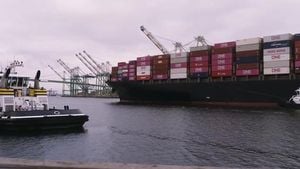A fire incident on Air Busan flight BX391, scheduled for Hong Kong, caused chaos at Gimhae International Airport yesterday evening. The aircraft, carrying 176 occupants including 169 passengers, six crew members, and one maintenance worker, was preparing for departure when flames broke out at approximately 10:26 PM.
According to reports, the fire ignited at the tail of the Airbus A321 shortly before takeoff. The blaze rapidly spread, prompting emergency measures from both the flight crew and the airport's fire services. Passengers were directed to evacuate via emergency slides, resulting in all occupants escaping the aircraft. Although there were no fatalities, three individuals suffered minor injuries and were sent to the hospital for treatment.
The response from local firefighting units was swift. By 10:38 PM, firefighters had activated the first stage of their emergency response, deploying all available resources to combat the spreading fire. Firefighters from the airport and regional units worked diligently to control the situation, finally extinguishing the flames at approximately 11:31 PM—over an hour after the initial outbreak.
Eyewitnesses described the scene as frantic but orderly, with passengers cooperating to find exits amid confusion. "There was confusion, but we managed to escape through the exits," recounted passenger Kim Dong-wan. "We heard fire alarms and saw smoke coming from the rear. It was scary, but we stayed calm and followed instructions as much as we could."
Officials have stated the cause of the fire is still under investigation. The Ministry of Transportation has dispatched investigators to assess the situation, with additional focus on determining why the flames spread so quickly throughout the aircraft. "The fire started at the tail and spread quickly to the body, almost entirely engulfing the plane," commented Kim Min-hyung from the Busan fire department during their assessment post-incident.
This incident had ripple effects, resulting in the delayed departures of two other outbound flights. Passengers for flights bound for Taiwan and the Philippines experienced delays of around 40 minutes due to the emergency response near the affected aircraft. The Korean Airport Corporation confirmed they were monitoring the situation closely and would update passengers about the flight schedules.
The incident has raised concerns about safety protocols during pre-flight checks, especially as it was reported the aircraft was relatively seasoned, being built back in 2007. The aircraft had undergone extensive checks but this devastating fire raises questions about adhering to safety protocols stringently.
The Ministry of Infrastructure reiterated their commitment to ensuring the thorough investigation of this incident, highlighting the need for rigorous future safety measures. "The Ministry of Infrastructure has mobilized teams for thorough investigation and support," assured officials. Public confidence is imperative for the air travel sector, and swift action taken post-crisis will be pivotal for restoring it.
Overall, Air Busan flight BX391's incident is not only alarming but also serves as a stark reminder of the risks associated with air travel. The cooperation of passengers and crew thwarted what could have been a greater tragedy, and continuous upgrades to safety measures will be necessary moving forward as the investigation continues.



